Summary
Indian large caps, after years of overvaluation, are nearing fair value. Key metrics like P/E, P/B, and the India premium vs. EM peers show valuations returning to historical norms. While some froth remains, a moderate allocation may now be reasonable. Read Netra for deeper insights.
The post-Covid years saw most global stock markets make a thumping recovery, and the Indian market was no exception.
As can be seen in the chart below, the overall Indian market (represented by the Nifty 500), as well as the main market-cap-based indices rose at least 3x between March 2020 and September 2024.
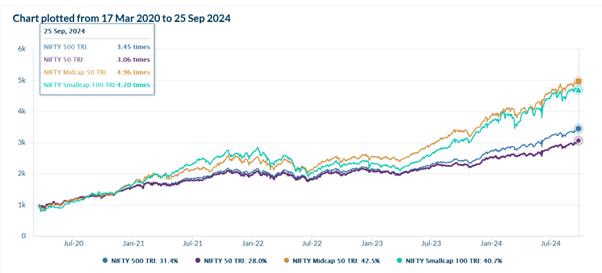
Source: DSP internal
However, this dizzying rise was rightfully accompanied by concerns that the market was becoming frothy, i.e. that stock valuations were getting decoupled from fundamentals due to investor overexuberance.
So although the steep market decline that began in September 2024 has rattled retail investors, the silver lining is that this decline is bringing valuations closer to reasonable levels once again, with this effect being especially pronounced for large caps.
Let’s back up this latter claim by looking at various valuation metrics*.
1. The Nifty 50 P/E ratio
For starters, the price-to-earnings or P/E ratio of the Nifty 50 is currently close to its long-term average after having been mostly higher over the last couple of years.
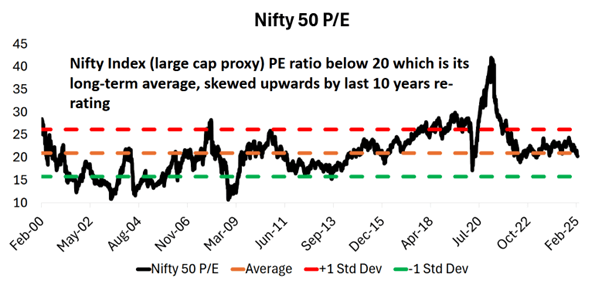
2. The Nifty 50 P/B ratio
Similarly, the Nifty 50’s price-to-book or P/B ratio, which is another common metric used to gauge valuation levels, is close to its long-term average right now.
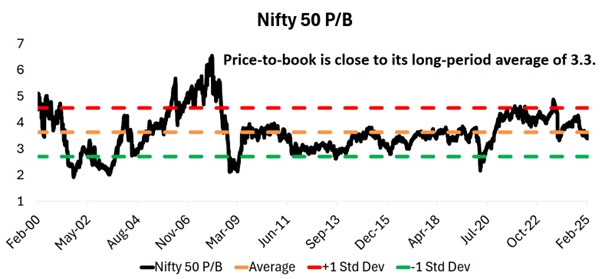
3. The “India premium” compared to other emerging markets
Next, let’s look at the MSCI India index and compare it to the MSCI EM (emerging markets) index. Soon after Covid, the premium that India commanded over its EM peers climbed higher than its long-term average, and stayed that way until relatively recently: it finally came very close to this average in February 2025.
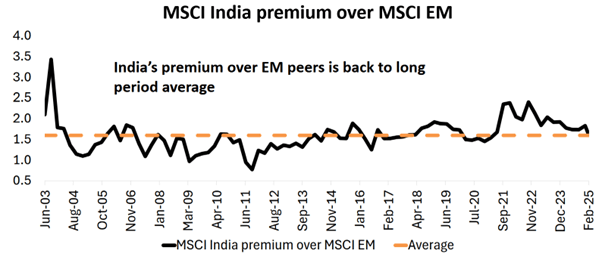
4. India’s market cap v/s its GDP
The ratio of a country’s stock market cap to its GDP (sometimes called the ‘Buffett indicator’ due to Warren Buffett’s endorsement of this metric as being “probably the best single measure of where valuations stand at any given moment”) is akin to a price-to-sales ratio for an entire country.
Currently, unlike the three metrics above, this long-term valuation metric as applied to India indicates that while valuations certainly are becoming fairer, the froth will need some more time to be fully washed off, as can be seen in the chart below.
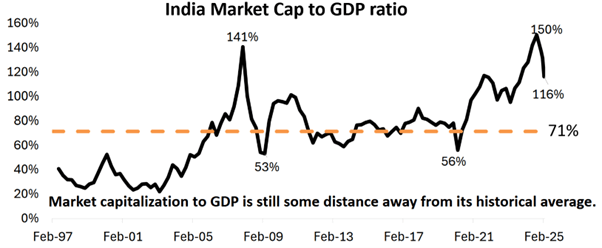
The combined message from these four valuation metrics seems to be that Indian large caps, after having been overvalued for several years, are finally returning to a zone where they’re more fairly valued. As a result, they might merit a moderate allocation in your portfolio at this point.
For more actionable insights backed by data and analyses, we invite you to read the latest edition of Netra in its entirety.
Source: NSE, CMIE, DSP. Data as of Feb 2025. For Feb 2025 we have considered March estimate GDP.
Industry insights you wouldn't want to miss out on.
Disclaimer
This blog is for information purposes only. The recipient of this material should consult an investment /tax advisor before making an investment decision. In this material DSP Asset Managers Pvt. Ltd. (the AMC) has used information that is publicly available, including information developed in-house and is believed to be from reliable sources. The AMC nor any person connected does not warrant the completeness or accuracy of the information and disclaims all liabilities, losses and damages arising out of the use of this information. Data provided is as of July 2024 (unless otherwise specified) and are subject to change without notice. Past performance may or may not be sustained in the future and should not be used as a basis for comparison with other investments. These figures pertain to performance of the index and do not in any manner indicate the returns/performance of this scheme. The statements contained herein may include statements of future expectations and other forward-looking statements that are based on prevailing market conditions / various other factors and involve known and unknown risks and uncertainties that could cause actual results, performance or events to differ materially from those expressed or implied in such statements.
All content on this blog is the intellectual property of DSPAMC. The User of this Site may download materials, data etc. displayed on the Site for non-commercial or personal use only. Usage of or reference to the content of this page requires proper credit and citation, including linking back to the original post. Unauthorized copying or reproducing content without attribution may result in legal action.. The User undertakes to comply and be bound by all applicable laws and statutory requirements in India.
Mutual Fund investments are subject to market risks, read all scheme related documents carefully.























Write a comment